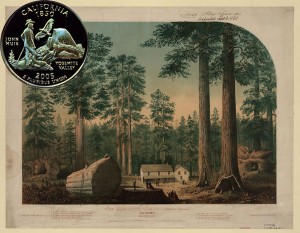Today, the California State Quarter Coin remembers the Congressional action on September 25, 1890 that established California’s Big Tree Park.
The legislation began:
An act to set apart a certain tract of land in the State of California as a public park.
Whereas, the rapid destruction of timber and ornamental trees in various parts of the United States, some of which trees are the wonders of the world on account of their size and the limited number growing, makes it a matter of importance that at least some of said forests should be preserved :
Therefore,
Be it enacted by the Senate and House of Representatives of the United States of America in Congress assembled, That the tract of land in the State of California known and described as township numbered eighteen south, of range numbered thirty east, also township eighteen south range thirty-one east ; and sections thirty-one, thirty-two, thirty-three, and thirty-four, township seventeen, south range thirty east, all east of Mount Diablo meridian, is hereby reserved and withdrawn from settlement occupancy, or sale under the laws of the United States, and dedicated and set apart as a public park, or pleasure ground, for the benefit and enjoyment of the people; and all persons who shall locate or settle upon, or occupy the same or any part thereof, except as hereinafter provided, shall be considered trespassers and removed therefrom .
Approved, September 25, 1890.
Just a few years later in the Rules and Regulations, Sequoia and General Grant National Parks published in 1920, the United States National Park Service provided a description of the park along with a nearby similar park in California:
=====
Sequoia and General Grant National Parks.
General Description.
The Sequoia and General Grant National Parks are in western central California.
The former was created by the act of September 25, 1890, and contains 252 square miles, or 161,597 acres; the latter was established October 1, 1890, and contains 4 square miles, or 2,560 acres.
They are situated on the Sierra Nevada’s warmest slopes and contain some of the most luxuriant forests of America. They are the big-tree national parks in every sense.
Here all native growths attain their greatest girth and height. The pines, firs and cedars are the noblest of their kind. Their open glades are gardens of wild flowers.
But their chief glory is the tree after which the parks are named, the Sequoia gigantea or Washingtoniana, popularly known and widely celebrated as the Big Tree of California.
Sequoia National Park contains a great forest —the “Giant Forest” of sequoia trees of all sizes, numbers of which exceed 10 feet in diameter. Among these are many monsters of great age.
The General Sherman tree, most celebrated of all, is 279.9 feet high, with a diameter of 36.5 feet. It is the biggest and the oldest living thing.
The Abraham Lincoln Tree is 270 feet high with a diameter of 31 feet.
The William McKinley Tree is 290 feet high, with a diameter of 28 feet.
These trees occur in 12 groves scattered through the park.
The largest and most famous of these is the Giant Forest, on whose 3,200 acres is a forest of sequoia trees, of which numbers exceed 20 and many 30 feet in diameter.
Here is found the General Sherman Tree and many of his peers. Giant Forest is also the name of the post office and village under the big trees and has a summer population of over 1,000.
The automobile road from Visalia or Exeter via Lemon Cove has now been completed to a point on the Marble Fork of the Kaweah River five miles beyond Giant Forest.
The country is one of the most beautiful in America; abounding in splendid streams, noble valleys, striking ridges, and towering mountains.
An ever-increasing number of campers-out inhabit these forests during the long and usually rainless summers. There is excellent trout fishing.
Thirty-one miles away by trail or 85 by automobile, across the mountain, valley, and forest, lies the General Grant National Park.
It was created to reserve for the public benefit the General Grant Tree and its splendid group of fellows.
In this grove, which is as luxuriant in all growing things as the Giant Forest, are 10,000 sequoia trees, 190 of which exceed 10 feet in diameter.
The General Grant Tree, which is second only to the General Sherman Tree in age and size, is 264 feet high and has a diameter of over 35 feet.
A distinguished neighbor is the George Washington Tree, which is only 9 feet less in height and 6 feet less in diameter.
The General Sherman and Genera Grant Trees are both nearly 4,000 years old.
=====
The California State Quarter Coin shows against an image of the Big Trees, circa 1860.
